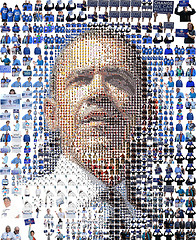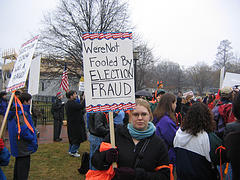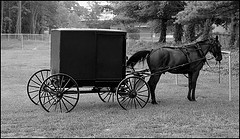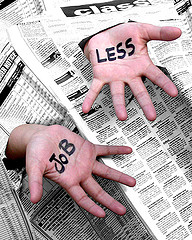
Priming you to vote for Obama? (Obama mosaic of people image by tsevis)
Priming is the influencing of an outcome by exposing people to some stimulus in advance (a picture, a concept, an advertisement) that then influences their subsequent outcome in systematic ways. Nobelist Daniel Kahneman and others talk about the pervasiveness of this effect and how it can influence voting…
KAHNEMAN: “…We are all aware that our behavior and our thoughts and feelings are highly context-dependent: none of us is quite the same person at home and in the office, in bed or in the subway. We are used to the context-dependency of our behavior and we have stories that make sense of it—social pressure, norms etc. What we are learning from the priming-anchoring effects is that context-dependency is mediated in part by multiple subtle cues of which we are not necessarily aware. ”
The effects according to Kahneman are systematic and pervasive (with a HOST of examples). The magnitude of the effect is not negligible but not overpowering. And the effect doesn’t always persist. It happens without us being aware of the prime (and even consciously explaining that the priming influence did NOT influence our behavior), but it affects us nonetheless, unless on issues on which we have irrevocably made up our mind.
This dialogue is taken from a fascinating conversation on Edge 262 with W. Daniel Hillis, Kahneman, Nathan Myhrvold, Richard Thaler, Elon Musk, France LeClerc, Salar Kamangar, Anne Treisman, Sendhil Mullainathan, Jeff Bezos, and Sean Parker.
MYHRVOLD: You can make Democrats and Republicans by threatening them with death? That’s fascinating!
KAHNEMAN: Those effects would be small at the margin, but there are those effects that are small at the margin that can change election results.
You call and ask people ahead of time, “Will you vote?”. That’s all. “Do you intend to vote?”. That increases voting participation substantially, and you can measure it. It’s a completely trivial manipulation, but saying ‘Yes’ to a stranger, “I will vote” …
MYHRVOLD: But…suppose you had the choice of calling up and saying, “Are you going to vote?”, so you prime them to vote, versus exhorting them to vote.
KAHNEMAN: The prime could very well work better than the exhortation because exhortation is going to induce resistance, whereas the prime ‚the mild embarrassment causes you to make what feels like a commitment, and the commitment, if it’s sufficiently precise, is going to have an effect on behavior.
THALER: If you ask them when they’re going to vote, and how they’re going to get there, that increases voting.
KAHNEMAN: And where….Here is a study, this one will demonstrate that those effects are not so weak. You look for support for school bonds, and what you look for is where were the polling stations. When the polling station is in a school, you get measurable effects on the support for school bonds. They increase. That is non-trivial, it’s in the real world, except that you have something that is focused, you know what the direction is. You expose a lot of people to the prime, and you observe the behavior, and it’s quite measurable.
THALER: And to answer your question, on that one, my recollection is the magnitude is something like 2 or 3 percent. It’s not a huge effect, but a noticeable effect.
KAHNEMAN: Yes, that’s what you would expect.
MULLAINATHAN: There is another response to this question. And I’ve struggled a lot with this question. If these effects are so big, how can it be, right?
There is another more controversial response to that, which is, let’s say that the two phenomena that are opposing each other is that people are relatively consistent and stable, but these effects suggest a lot of instability. One resolution to that is that, in fact, people are not consistent and stable …… and, the bias is that we think ourselves and others are consistent and stable when we’re not. There is good evidence that if you take even something as simple as stated preference for Democrat, Republican, test-retest validity on these things is tiny, risk aversion measures have tiny test-retest validity. One possible resolution control of this is that the mistake is on our end in presuming stable interpersonal characteristics.
KAHNEMAN: That’s a beautiful way of putting it, because one of the things that psychologists have been exercising over and over for decades is the relative impact of personality, if you will, or character or temperament—internal factors as against environmental factors in the control of behavior. We have a hugely powerful bias against the environment as a determinant of behavior. We tend to believe that somebody is behaving that way because he wants to behave that way, because he tends to behave that way, because that’s his nature. It turns out that the environmental effects on behavior are a lot stronger than most people expect.
KAHNEMAN: …Another condition is a pile of Monopoly money on a neighboring table. What would you guess, by the way? Those of you who have read it shouldn’t guess, but can you guess? I was stunned by the result, which I wouldn’t have predicted. But can you guess what priming people with money will do? They don’t want help. They’re on their own. They also don’t want to give help. You’ve got very clever ways of manipulating that, of observing that, but my favorite is the experimenter that comes in clutching a batch of pencils, and the pencils drop on the floor. The dependent variable of the study, the number of pencils the person picks up, is fewer if there is money on that screen saver.
MYHRVOLD: [On effect of playing Monopoly in advance]…Makes them Democrats?
HILLIS: Republican.
KAHNEMAN: It’s closer to making them Republican. It makes them individualists. And it’s quite deep, and very unexpected. It doesn’t make them good or bad, it just makes them different.
Here is the whole conversation on Edge 262.
Note: in another recent priming example relevant to social capital, scientists found that you feel warmer to someone you just met if you are holding a hot cup of coffee rather than a cold beverage. Not kidding…See study by Lawrence Williams (Univ. of Colorado) and John Bargh of Yale here in Science magazine.
For an interesting post not on priming, but on getting individuals to make commitments to voting, see the Freakonomics blog post on how to improve efficiency and effectiveness in the voting process through enforcable commitments to vote in Ian Ayres’ “A Political Do Not Call List“.









